Of Narwhalz & Dolphins: A Conversation With Brian Blomerth
The graphic novelist discusses his new book about John C. Lilly, the psychedelic research pioneer who injected dolphins w/LSD & invented the isolation tank
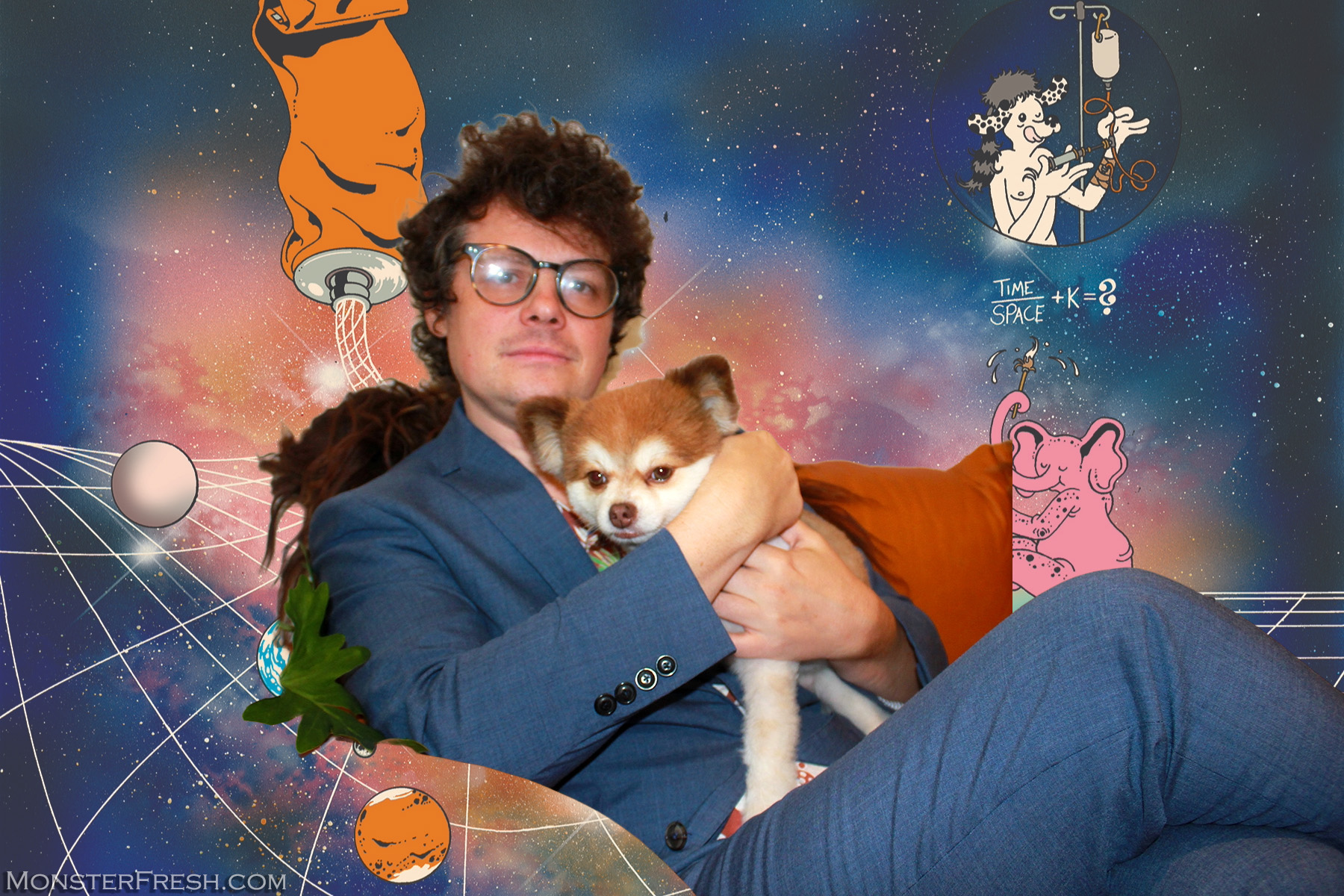
I rolled out of bed with a mission to finally wrap up the questions for my interview with Brooklyn-based illustrator/cartoonist, Brian Blomerth. It was Bandcamp Friday. As I drove to a local coffee shop, I listened to The 12″ Synth by OSEES for the first time. Recorded by Jon Dwyer during a birthday LSD trip, this 2019 LP had somehow eluded me. With the gentle sound of sloshing water intermittently surfacing through blankets of shifting sonar-like tones, the record unfolds like the soundtrack to being dosed up in a dolphin tank.
That morning, I also ordered Yo La Tengo‘s The Sounds Of The Sounds Of Science, a 2002 effort consisting of scores the trio had composed for a collection of obscure French undersea documentary shorts. Just the day before, I’d been lamenting about not picking it up a year ago, before it went out of print. Extra copies were serendipitously unearthed less than 24 hours later. It seemed like a number of odd coincidences had been occurring ever since I began preparing for this interview.
The titular subject of Blomerth‘s new book is someone who promoted the idea of cosmic coincidences, along with our duty of recognizing and yielding to them. Lilly Wave marks Brian‘s 3rd in a series of graphic novels chronicling the achievements of pioneering psychedelic researchers. This time around, his focus is on American multi-hyphenate, Dr. John C. Lilly (1915 – 2001), and, to a lesser extent, volunteer researcher, Margaret Howe Lovatt. As a physician, neuroscientist, psychonaut, psychoanalyst, philosopher, inventor, and author, Lilly left behind a dense, polarizing legacy full of controversial, yet groundbreaking, theories, experiments, books, and research papers on topics ranging from marine biology to the transcendental properties of hallucinogens, and the parallels of computer technology with the human brain and systems of anatomy. Two of his most recognized accomplishments are the development of the sensory deprivation tank and foundational studies in dolphin communication. Beyond his impact on the scientific world, the influence of John C. Lilly has seeped into popular culture and entertainment through film, television, music, and video games. The 1980 Ken Russell film, Altered States; the 1960s TV show, Flipper; SEGA‘s Ecco The Dolphin video game series; and the 2001 Oysterhead song, “Oz Is Ever Floating,” all drew inspiration from his work. It’s a lot to wade through, but the brilliance of Lilly Wave is that it manages to consolidate and provide context for some of the most important moments and aspects of the doctor’s life, while presenting them in a visually stunning, endlessly engaging, and surprisingly informative merger of art and literature.
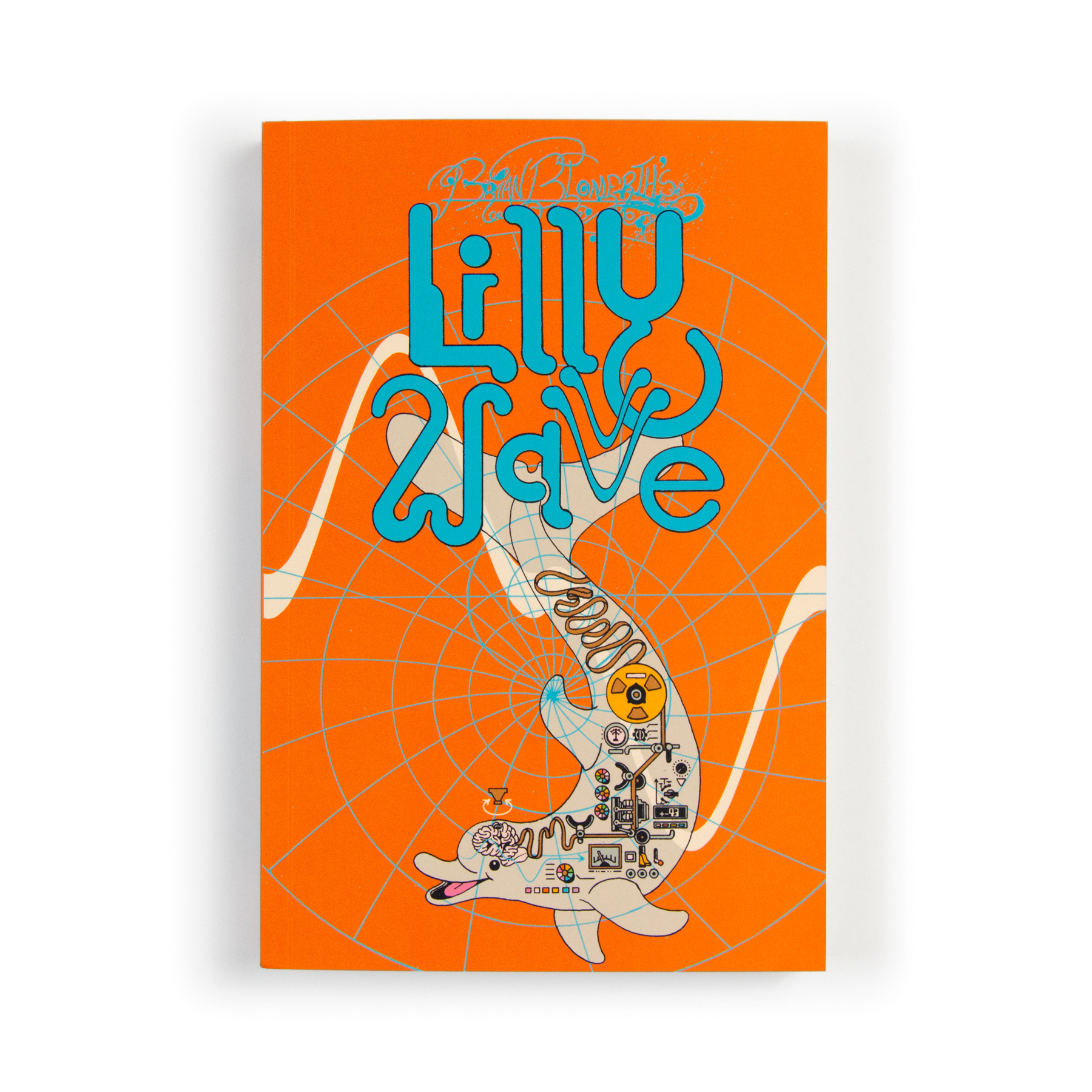
Brian Blomerth‘s history suggests a similarly complex and layered creative with numerous skill sets and a willingness to dive face-first into whatever interests him. Looking into the artist’s past, you’ll discover a prolific output of music under variations of his moniker, Narwhalz (Of Sound), and black-and-white footage of him twiddling knobs at a chip-tune-meets power electronics noise show as an overly enthusiastic crowd envelopes him, pulls him from the stage, and tears away his clothing. You’ll find references to Brian‘s time as a paid test subject for lab experiments and a viral TV appearance where he addresses Judge Judy as “mama” during a dispute over a murdered house cat. But whether it’s creating album covers, zines, and comix; designing and selling limited edition shirts; or collaborating with Australian sustainable knitwear label, Wah-Wah; art has remained a constant in Blomerth‘s life. He hosted a crafting podcast, at one point, and drew recurring comic strips for Vice and Merry Jane Magazine. Then there’s the work he’s done creating album art, merch, and/or poster designs for musicians like George Clanton & Nick Hexum, King Gizzard & The Lizard Wizard, Grateful Dead, Fleet Foxes, Phish, and his friend/fellow Virginia native, Travis Miller aka Lil Ugly Mane. Another constant is Blomerth‘s trademark of rendering characters as loveable anthropomorphic canines.
Out of everything he’s accomplished, this book series through Anthology Editions might be the most ambitious thing we’ve witnessed from the self-proclaimed “comic stripper” and, arguably, the most successful. If you’ve read our extensive review of Bicycle Day (2019), then you’ll know how impressed we were with his take on the events surrounding Albert Hoffman‘s synthesis and first intentional ingestion of LSD. That quality and attention to detail carried over into his follow-up, Mycelium Wassonii (2021), documenting the role that scientist couple, R. Gordon and Valentina Wasson, played in the widespread popularization of psychedelic mushrooms. Lilly Wave is just as strong as its predecessors, if not stronger. Measuring a respectable 6 x 9 inches and 220 pages, Blomerth is taking the “novel” in “graphic novel” seriously. As with the previous two, this is an incredibly solid, fully illustrated, and remarkably well-researched book packed with beautiful artwork and a wealth of information.
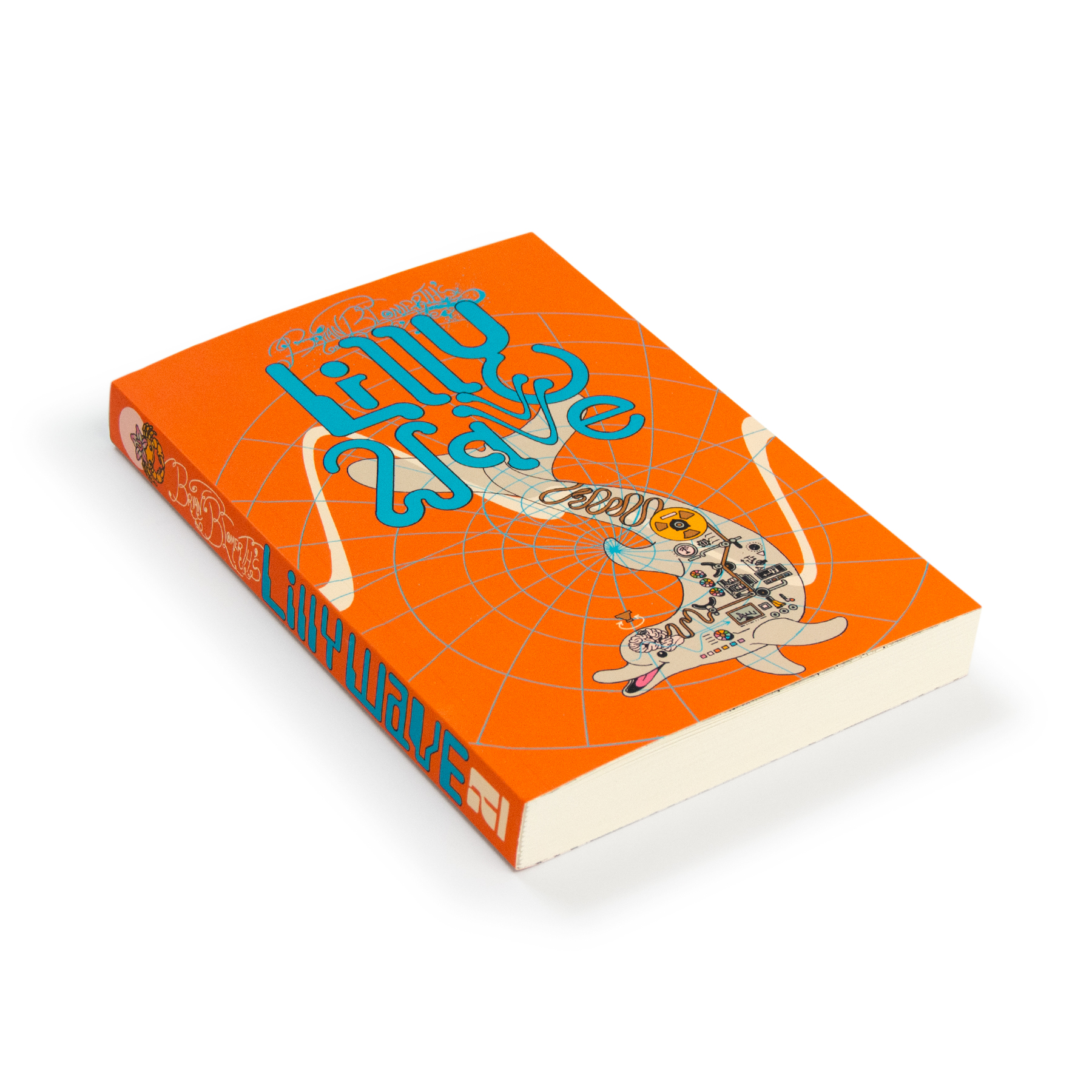
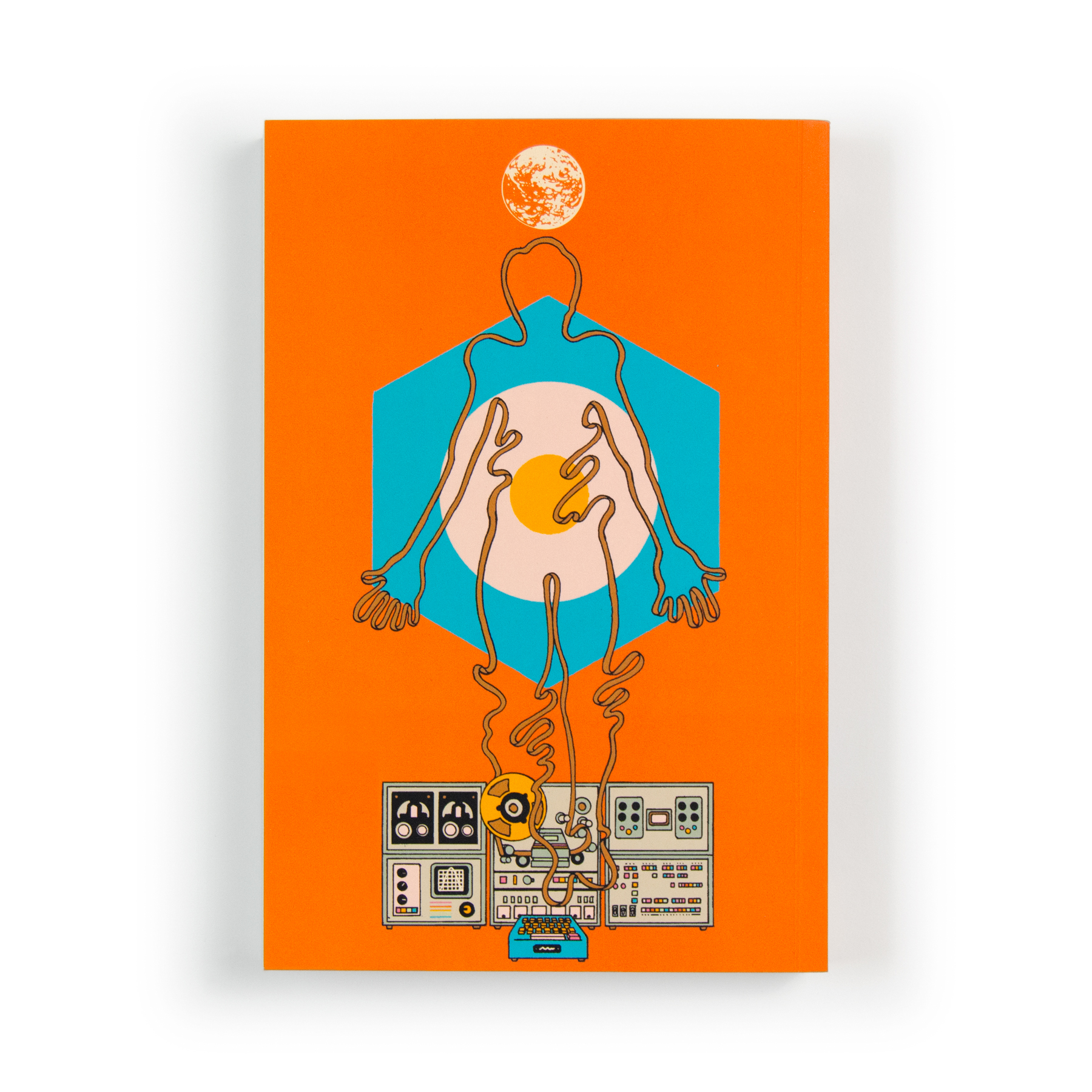
It would have been easy to rely solely on the most sensational aspects of these stories, but Blomerth reaches for something greater and achieves it. I have to imagine that books a fraction of the size – if filled with nothing but wacky illustrated dog people spun out on psychedelics – would still sell, but they wouldn’t offer nearly the same level of substance. This rings especially true with a character as eccentric as John Cunningham Lilly. Drunk on his obsession with teaching dolphins to “speak” English, Lilly steered his NASA-funded experiments off the rails by injecting the marine mammals with LSD. Meanwhile, Lovatt made the executive decision to manually pleasure an adolescent bottlenose named Peter as part of her regular teaching regimen. [The dolphin would later commit suicide, after being relocated once the facility lost funding]. John would eventually become lost in the sauce with a ketamine dependency. The good scientist often administered the substance to himself during isolation floats, resulting in multiple near-death experiences. In other words: WILD SHIT. The real achievement is how Brian capably integrates these details with restraint, delivering emotion and depth without allowing it to fully unravel into a superficial, one-dimensional spectacle.
In a lesser artist’s hands, these projects could be reduced to a series of fun, yet disposable, “drug books,” but Blomerth‘s reverence for the subject matter shines through. Although light-hearted and enjoyable to consume, the scientific and historical content interlaced in these works makes their educational value difficult to refute. This is why the graphic novelist has been able to get introductions written by ethnopharmacologist/author/lecturer, Dennis McKenna (Bicycle Day); mycologist/author/speaker, Paul Stamets (Mycellium Wassonii); and, now, Rick Doblin, founder of The Multidisciplinary Association for Psychedelic Studies (MAPS), for Lilly Wave. These renowned figures in psychedelic research are willing to co-sign Brian‘s projects because they recognize the unique value he’s contributing to fields of study they’ve dedicated their lives to. This is also why we seized the opportunity to communicate with Blomerth when it presented itself.
The following interview was conducted via email over the 2024 holiday season.
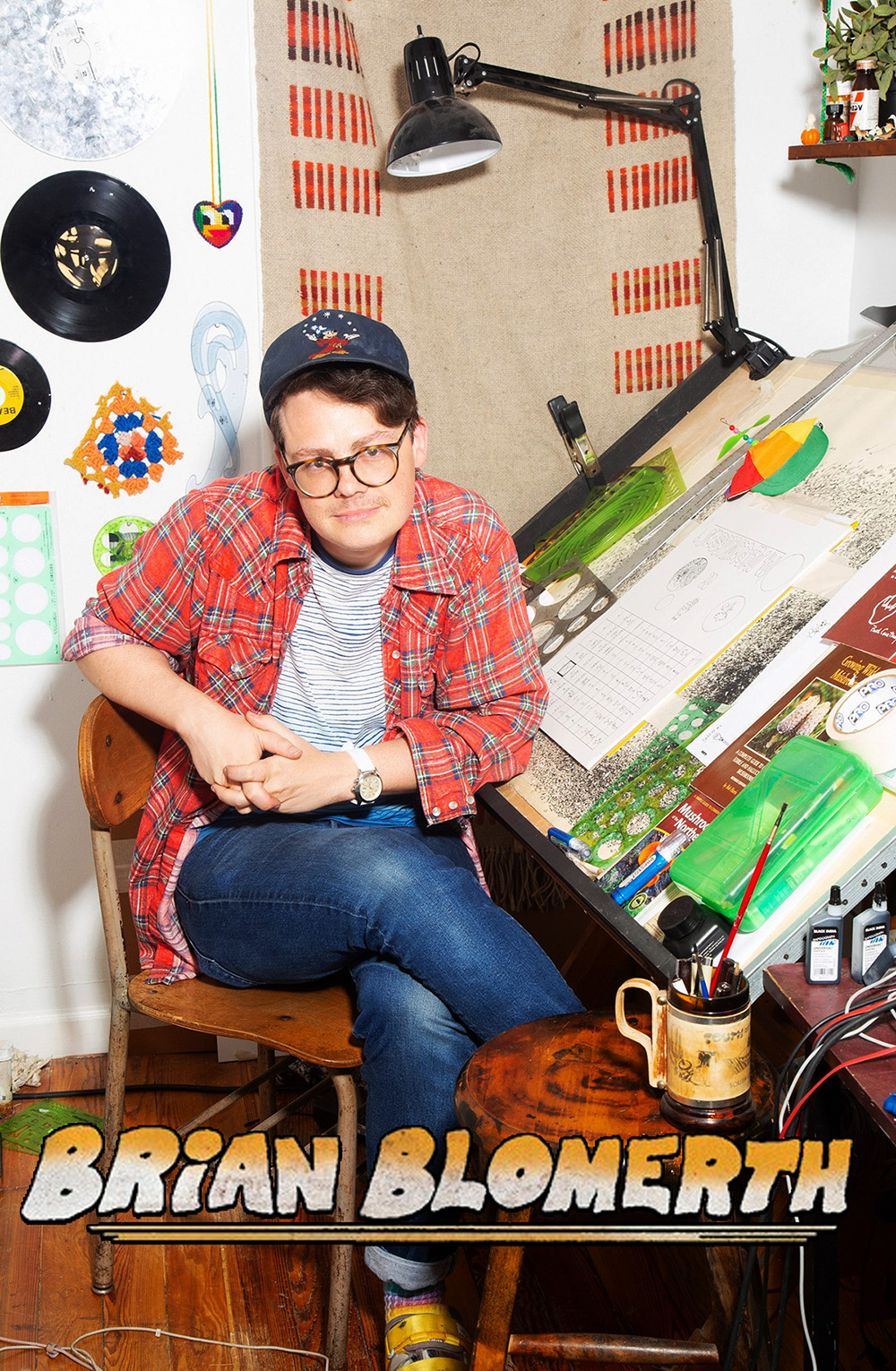
MONSTER FRESH: I first came across your work through Lil Ugly Mane and Secret Circle merch, before later seeing it on album covers for artists like Ryley Walker, Pictureplane, and North Americans. Before any of that, you were making art for your own releases. Did your commission work start from friends liking what you were doing and asking you to do something for their projects?
BRIAN BLOMERTH: Yeah, I think that’s the only way things like that ever start. Think you have to work. Put it out there…and then people may or may not come knocking. Knock on wood…people keep knocking.
You often dismiss your musical past as more of a former interest, choosing to focus on your prolific career as a visual artist. Despite this, publications consistently include the word “musician” when describing you. The one outlet that I didn’t see do that was MoMA.
In 2019, the museum tapped you to create a terrific playlist of synthesizer-based compositions to honor the 50th anniversary of Bob Moog’s performance closing out their 1969 Jazz In The Garden festivities. That Moog concert is credited as being the first instance of synthesizer use in a live performance outside of a studio. In their accompanying post, MoMA simply referred to you as a “Brooklyn-based illustrator and cartoonist;” ignoring your history with electronic music in the one instance it seemed most relevant. While fully acknowledging your talents as a visual artist, they requested something music-related. Have you worked with MOMA in any other capacity before or since?
No, that was it. I actually don’t know why I got asked to do that playlist.
I came across another post where a website asked you to “pick five favorite [album] covers of all time.” Was there any album art that made an impact on you at an early age, or that you remember inspiring you to create one, someday?
Velvet Underground -“Loaded” I think is the best cover ever made. Always, draw the smoke from that — and drift farther and farther away… and then when I see it again. The smoke is back.
In 2020, you created Cornhatch’s Party Patch for the Desert Island comics newsprint “comic tabloid,” Smoke Signal. I watched a video where you joked about “hoping and praying” that, because the publication was “given away for free,” you wouldn’t face any “legal problems” over all the blatant Grateful Dead-related imagery and references being incorporated. 2 years later, your work was heavily featured in the Europe 72 reissue campaign, appearing on everything from clothing and an art print to gracing the slipcase and booklet of the massive 24-disc Lyceum Theater box set. I’m fascinated to hear how that came about.
Was getting that gig related to what you showcased in Smoke Signal? Some of the artwork, such as the goose, looks as if it might have been carried over directly from one project to the other.
I don’t think they saw that at all. Or are even aware of that, to be honest? I have done a couple of things for Warner over the years…and a couple of things for the Grateful Dead through Warner…so think that is more how it happened.
The Kelley/Mouse artwork For Europe 72 is so iconic. How daunting was it to be tasked with contributing to the Dead’s rich visual history occupied by names like theirs, Rick Griffin, Bob Thomas, and Victor Moscoso?
Pretty Daunting! Don’t think my work compares to theirs at all…but obviously, I love all their work. So was great to add my two cents very late to the cannon.
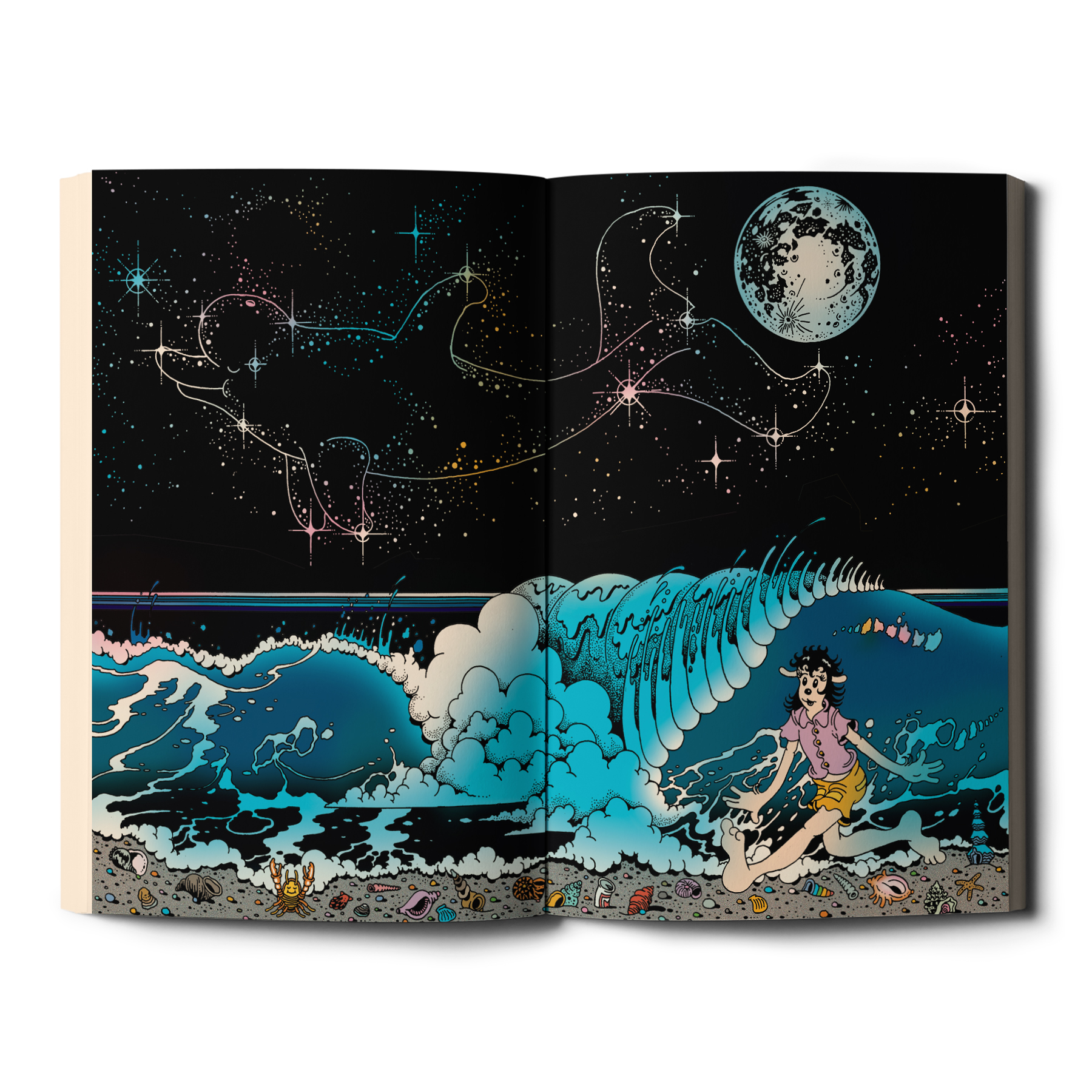
Being a participant in greater legacies is something you’ve spoken about, especially in regards to your style of “Adult Contemporary Dog-Face” being inspired by the tradition of artists like Carl Barks working in the “funny animal genre” of cartoon illustration. Margaret Lovatt has stated that, as a kid, her mother gave her a book titled Miss Kelly “about a cat who could talk and understand humans.” She credits that as making her wonder if animals might have that “possibility.” She’s gone on to say that, over the years, she’s received letters from people who claim that reading about her work with Peter when they were children became the catalyst for them going into a field working with dolphins themselves. As she puts it, “Peter is their Miss Kelly.” Now things have come full circle as you add another link to that chain by rendering Lovatt as an anthropomorphic dog-person in Lilly Wave. Is that connection something you thought about when drawing her for the book?
I didn’t know any of that to be honest!
Because I’m a deviant, the first thing I did when I got my copy was open it to see if you had included Lovatt relieving Peter of his physical urges. You didn’t disappoint with a graphic frame-by-frame breakdown and a large full-page illustration smack in the middle of the book. Was the layout for that section something you worked out in your mind beforehand, or did you wing it? Did it take many revisions, or require research on dolphin anatomy?
I did that section on Christmas Day last year? So it’s almost been a year…wanted it to be like that….like the isolation tank wanted some parts to be very small and claustrophobic and then others to really open up. Dolphin anatomy I did look up…and yes it was gross
I enjoyed reading the Consumer Report feature you wrote for Art News. Have you ever attempted any day-in-the-life or autobiographical-style strips in the vein of R. Crumb or Harvey Pekar?
No, friends of mine bring it up and ask for it…but no one outside of my circle. Maybe one day when I’m an old man.
I found myself connecting to that Consumer Report piece as you attempted to stay on course while juggling various responsibilities. Whenever you’d mention turning on music, I would click the corresponding YouTube videos that were embedded and listen along. What I didn’t consider was that the videos don’t override the previous one, but play over one another and blend together. After accidently starting Pacific by Haruomi Hosono & Friends over Casio Works By Gust De Meyer, I stumbled into a pretty cool, “You got your peanut butter in my chocolate” situation. I let them both keep running simultaneously as I read along and, once I hit Yann Tomita, I added that to the mix.
I later realized I was subconsciously replicating the Consumer Report format in my notes. “I added Tomita 2 minutes later. It feels like I’m dying in sunglasses.” “Turned on ‘Crash’ about 43 seconds later and it’s the most demonic shit I’ve ever heard. Roky Erickson could fall asleep to this.” “2:40 and I play ‘Kiss Me.’ There’s a little disco groove and it sounds genuinely amazing.” “I put on Dilloway 1:47 in, right before ‘Crash’ ended…” As it slowly eased out, I tried to layer in Prefab Sprout, but felt like I was going to have a heart attack. I yanked my headphones off and took a break. I was sitting in a coffee shop, listening to chaos, and giving myself an anxiety attack, while reading about you managing your own anxiety level.
I originally took those notes for myself as a recipe to recreate what I heard and I know it’s an unorthodox move to shoehorn something like this into the middle of an interview, but I went back and chronologically layered all 10 songs mentioned into a single track. Since these are all your jams, I’m posting it below, so you can hear what your 5 day playlist might have sounded like if time had collapsed in on itself.
You reference both Dave Matthews and Obama in that Art News piece; the latter in context to hearing DJ Marley Marl mix one of his speeches into “The Humpty Dance.” Both come up again during a High Times interview where you discuss how you quit smoking weed after seeing Dave Mathews and Tim Reynolds perform a free, but unsettling, promotional concert for the Obama campaign at the VCWU Siegel Center in 2008 (I, actually, found a BitTorrent of that show). In the High Times article, you offer some anecdotes about random encounters with Matthews experienced by locals in the area. Oddly enough, I read both of these articles while sitting in a coffee shop where Dave once whispered in my ear that he “was following” me about 18 years ago. I had even mentioned it to the barista.
I never go to this shop – it’s near my old place in another part of town – but I decided it would be a good spot to research for this interview. The first day I set up in there, my headphones died, so I walked to a nearby record store. They were playing the North Americans Long Cool World LP with the jacket you designed on display. When I took a break due to that collage of overlapping noise music/chaos above, the first thing I overheard was 2 people discussing AA founder, Bill W. being a proponent of LSD use to treat alcoholism. These situations have been happening a lot lately.
Lilly had documented theories on “coincidences” influencing and directing our lives along with our roles in yielding, or laying the groundwork for them. Are you the type to make decisions based on something feeling oddly coincidental or “meant to be?” If so, are there any specific examples you could share where you did or did not take a particular action, based on a “coincidence” or cosmic feeling about whether or not you were supposed to?
Yeah, I’ve been known to do that from time to time!
The piece in art news is in this column my friend John Chiaverina used to do for them. Where, people in the arts discuss their media intake. I listen to music a lot to keep me motivated…and sometimes you only have a small part of the day to get a drawing done…so you really have to have the soundtrack work.
I like your inclusion of “The Three Beings” from E.C.C.O. (Earth Coincidence Control Office) directing Lilly’s life through “coincidence control.” Did he ever provide details on their appearance in his writings? If not, how did you come up with your illustrations for them?
Well, I believe they are beings made out of light…they somewhat resemble Casper or classic ghosts…as I was drawing them they naturally wanted to have pointy heads…and it just felt right.
Were these beings that he only witnessed while inside of the tank and/or under psychedelic influence, or did Lilly begin to notice them in their physical form throughout his everyday life?
Well, when he was on K they really hung around. He saw them in the tank—outside of the tank…it really took a couple of books for him to even admit or talk about those beings. Past the events in the book. They pick him up in a dune buggy and take him somewhere.
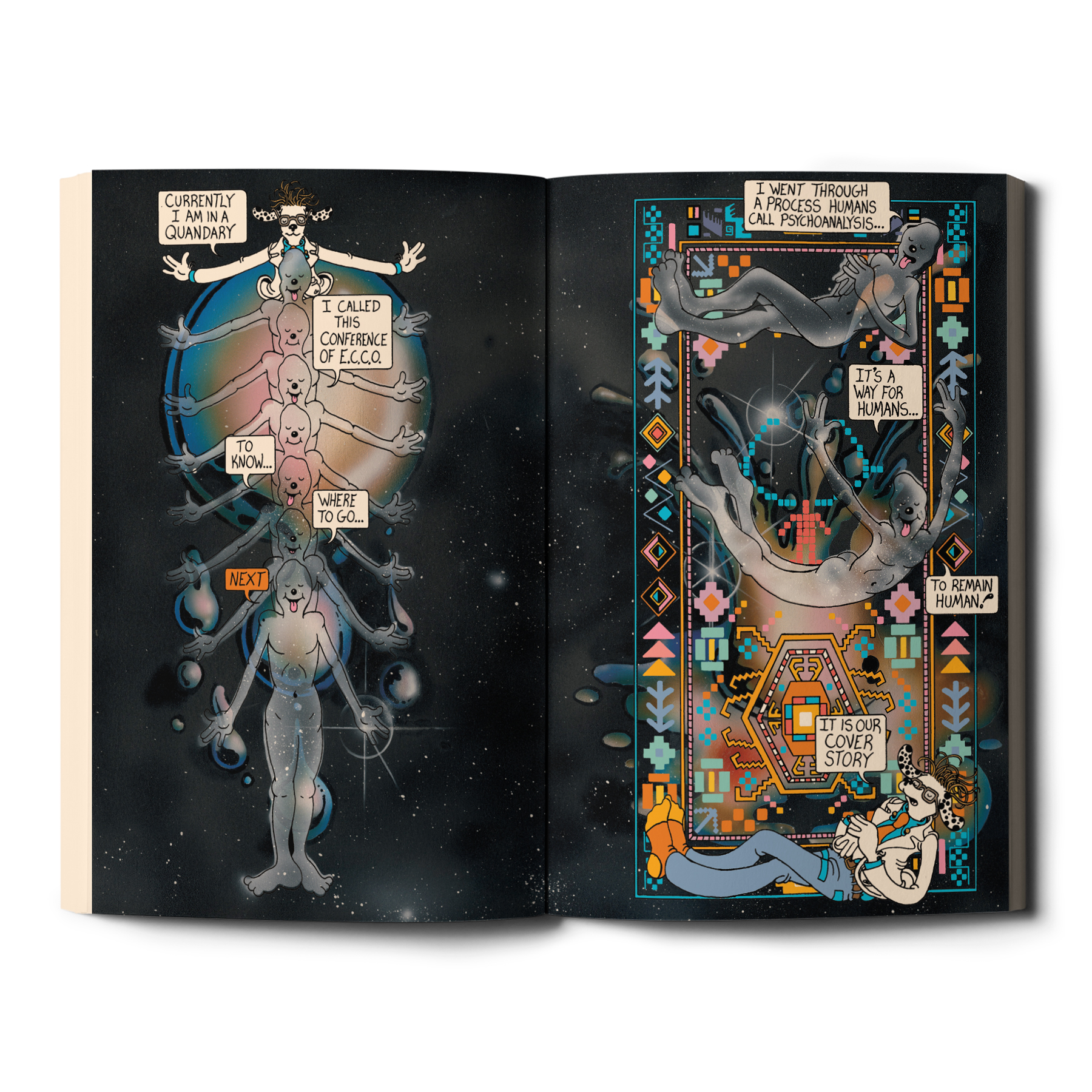
When I attended The Evergreen State College, a small group of students in one of my programs constructed an isolation tank. They would host experiments on campus, until the college put the kibosh on it. I was interested in participating, at first, but these kids became noticeably weirder as time went on. Every time I’d see them, they’d approach me with these wide, blank Village Of The Damned stares and repeat, “We need to get you in the tank, sometime” in gentle, monotone voices. They’d be smirking slightly like they had a secret. It was a bit unnerving and I still haven’t tried one.
Obviously, the tank wasn’t enough for Lilly, if he was willing to risk multiple ketamine-induced comas to amplify its effects, but did your research find him discussing any byproducts of prolonged exposure to the tanks themselves in those early trials? Have you had any experiences of your own with sensory deprivation?
I’ve been in the tanks a couple of times. I like it…but also I do sort of like small tight little spaces. It’s hard to tell what is long-term isolation vs. Lilly’s drug regimen.
You’ve discussed your time as a paid test subject for lab experiments, back in the day. More specifically, you’ve mentioned being injected with liquid nicotine and placed in an MRI machine. That theme has resurfaced from time to time through such projects as the Narwhalz (of sound) tape “MRI Menthol Moms” [2010]; and, later, in the comic, Understanding Nicotine, wherein “Japanese scientist” Dr. Isbip Osnotkitchi advocates for alternative applications of the drug (“nicotine sports drinks,” “nicotine pants and shirts,” “nicotine condoms,” etc). You also mix up your own vats of vape juice in Home Depot buckets in your garage. Lilly Wave showcases more lab experimentation than in your previous 2 books. At any point, did you flashback or draw from those old experiences while making it? Did you find yourself identifying with John C Lilly or his test subjects in any way?
Well, I’m off the sauce as far as nicotine goes. I got 100% nicotine free using the patch recently…and it turns out my life is a lot better without nicotine. So that’s hilarious.
Yeah, Lilly did work at one of the places I did medical studies at…and a very old lady that worked there knew him. That got me interested in Lilly and I read “The Scientist” for the first time around then. People on the edge of science and medicine—the line between professional and quack. Is of course pretty interesting.
With Bicycle Day you presented a well-known story through a new lens while correcting so many of the inaccuracies its tellings are regularly infected with. In Mycelium Wassonii, Valentina Wasson is finally given her flowers as the vital pioneer of mycology for which she’d never been sufficiently recognized. Is there one particular message or idea, above all else, that you are hoping to convey with Lilly Wave?
To be honest, I don’t entirely know. I guess this guy’s life and how wild it seems to me on the outside. It fit the couple and a compound arc I’m trying to do with these books. And like Bicycle Day…it felt like a story that had always been told to me wrong or off.
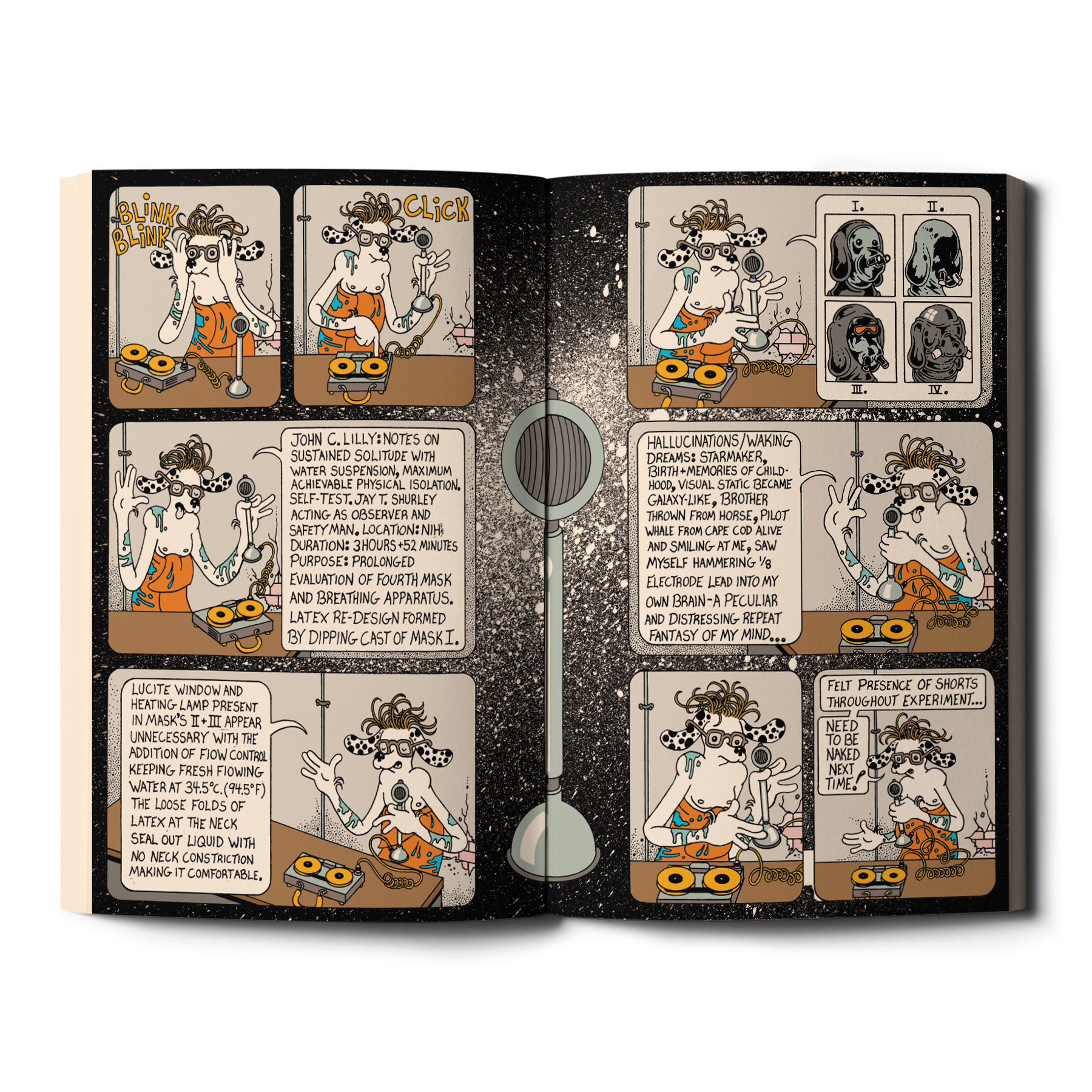
Bicycle Day read like a fully realized vision from the jump. Even the size and layout felt striking and original. You’ve maintained that strength through the sequels, connecting them as a cohesive series, while infusing each book with its own unique aspects that separate them from one another. Some of these choices seem informed by their respective subjects – Lilly Wave is much richer in dialogue, for example – but has anything changed or evolved in your overall process since the first book? What have you carried through from the beginning and what have you abandoned or refined?
For each of these books, I want there to be some sort of visual riff that ties to the compound to permeate through the book. For Bicycle Day…that was Neon Pantones. For Mycelium Wassonii…it was Watercolors and a hidden mushroom language. For Lilly Wave, I wanted splatter feedback, spirographs and cosmic airbrush.
So, once I’ve figured out some visual tropes…the books come together a lot easier. Had to do more dialog in this one for it to make sense…but the goal is always as simple as possible for these.
So much about your work relies on your control of pacing, whether it’s a tranquil opening sequence of John C. Lilly exiting an isolation session or the disorienting psychedelic experiences that appear in these books. One section in Lilly Wave that I find particularly effective is when the story alternates back and forth between John doing his LSD experiments and Margaret doing… what she does. It cuts and transitions like cinema with the build-up of conflicting energy ultimately syncing up in euphoria.
Do you operate primarily on feeling when you’re looking to evoke a specific mood or pacing? Are there any go-to rules like using particular colors, or drawing busier scenes in tight spaces for anxiety versus utilizing sparser illustrations to slow things down and create space?
For Lilly Wave I wanted to mimic the way the isolation tank works where it’s a small tight little space that opens up to a massive space. The real tight claustrophobic push/pull. For the most part—I do the pages in order as it goes…so all of that sort of comes from thinking about the next page while I’m doing the current page. Helps it feel fresh to me and not like I’m slogging through the mud page after page.
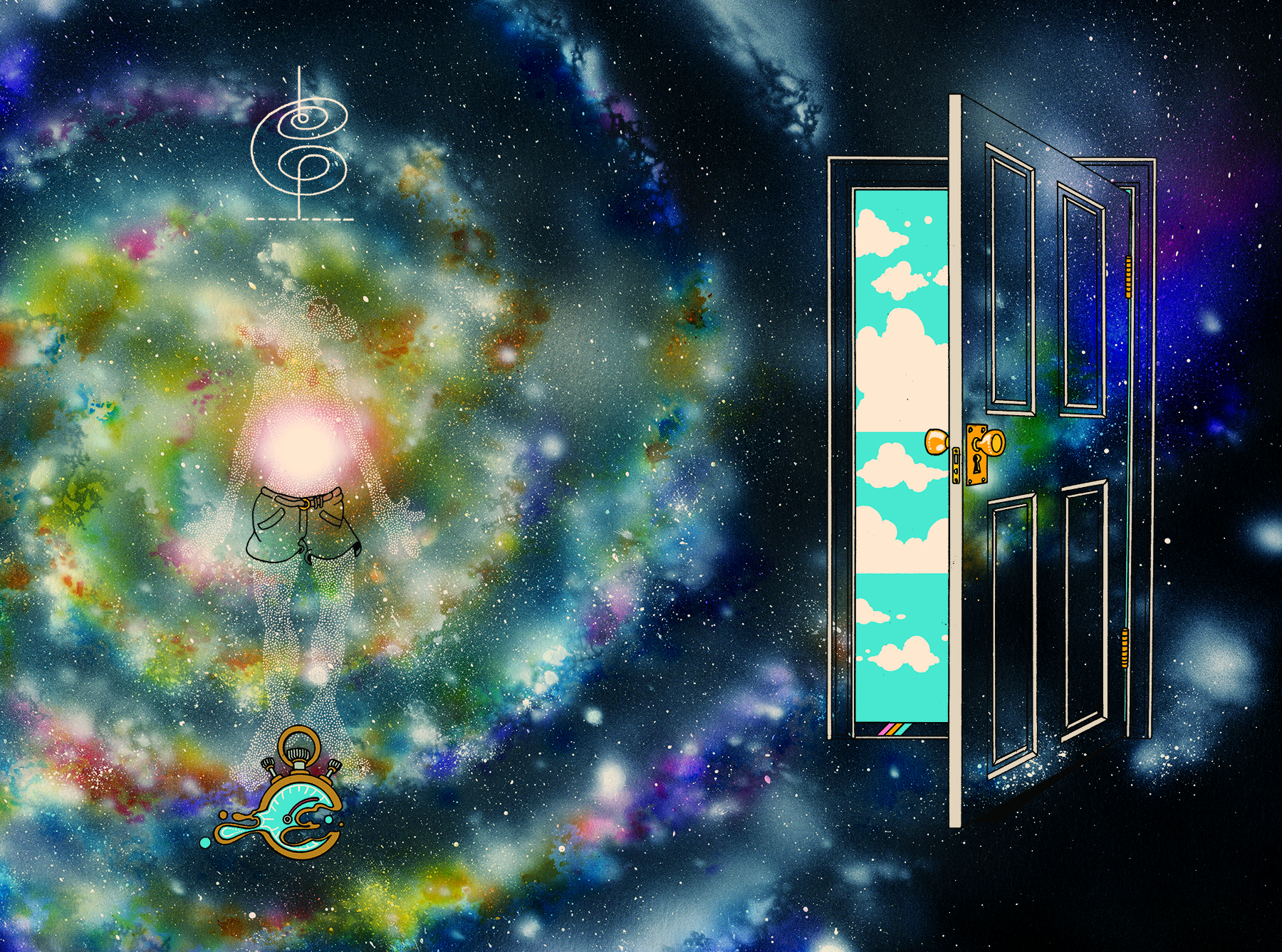
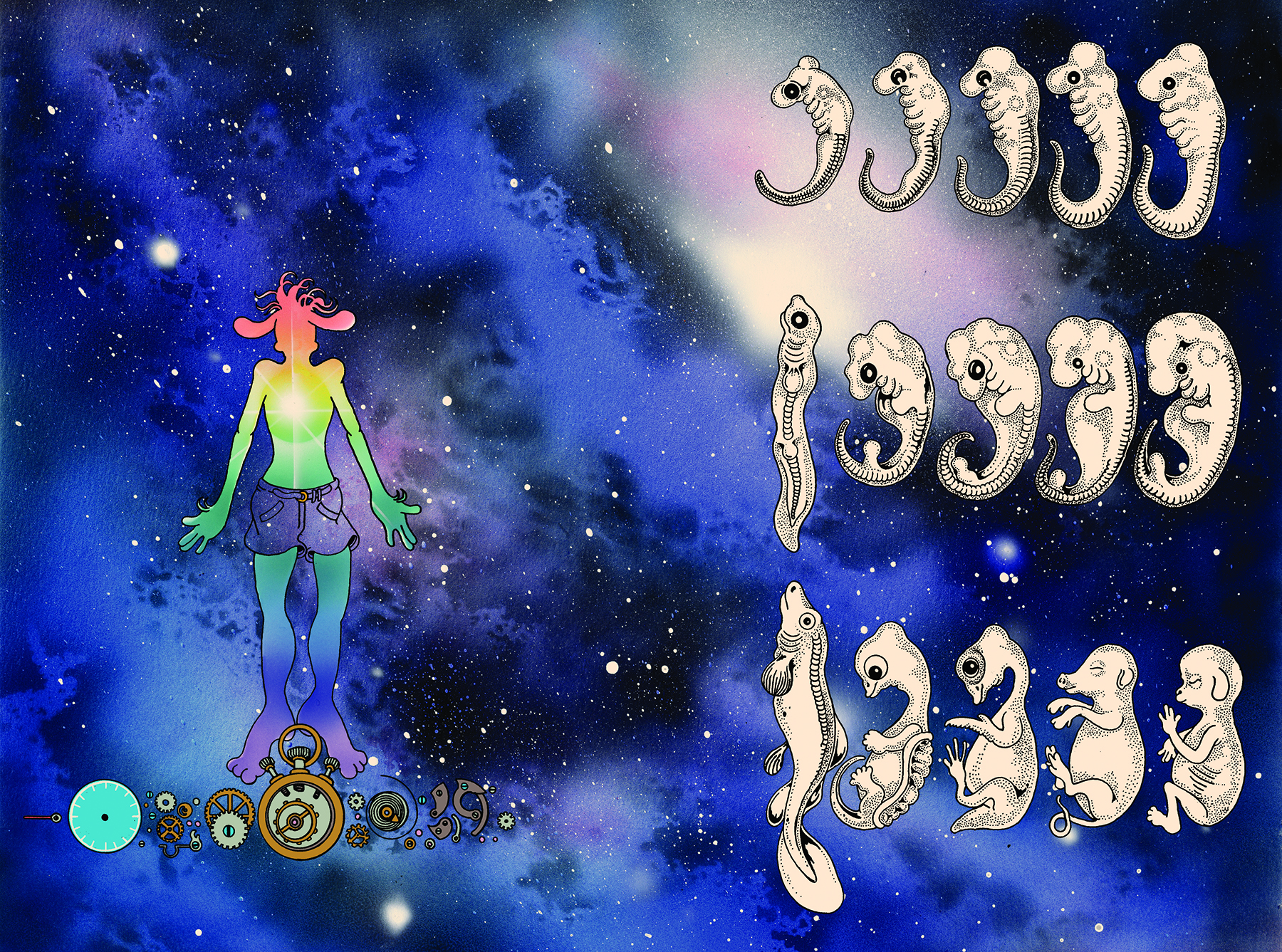
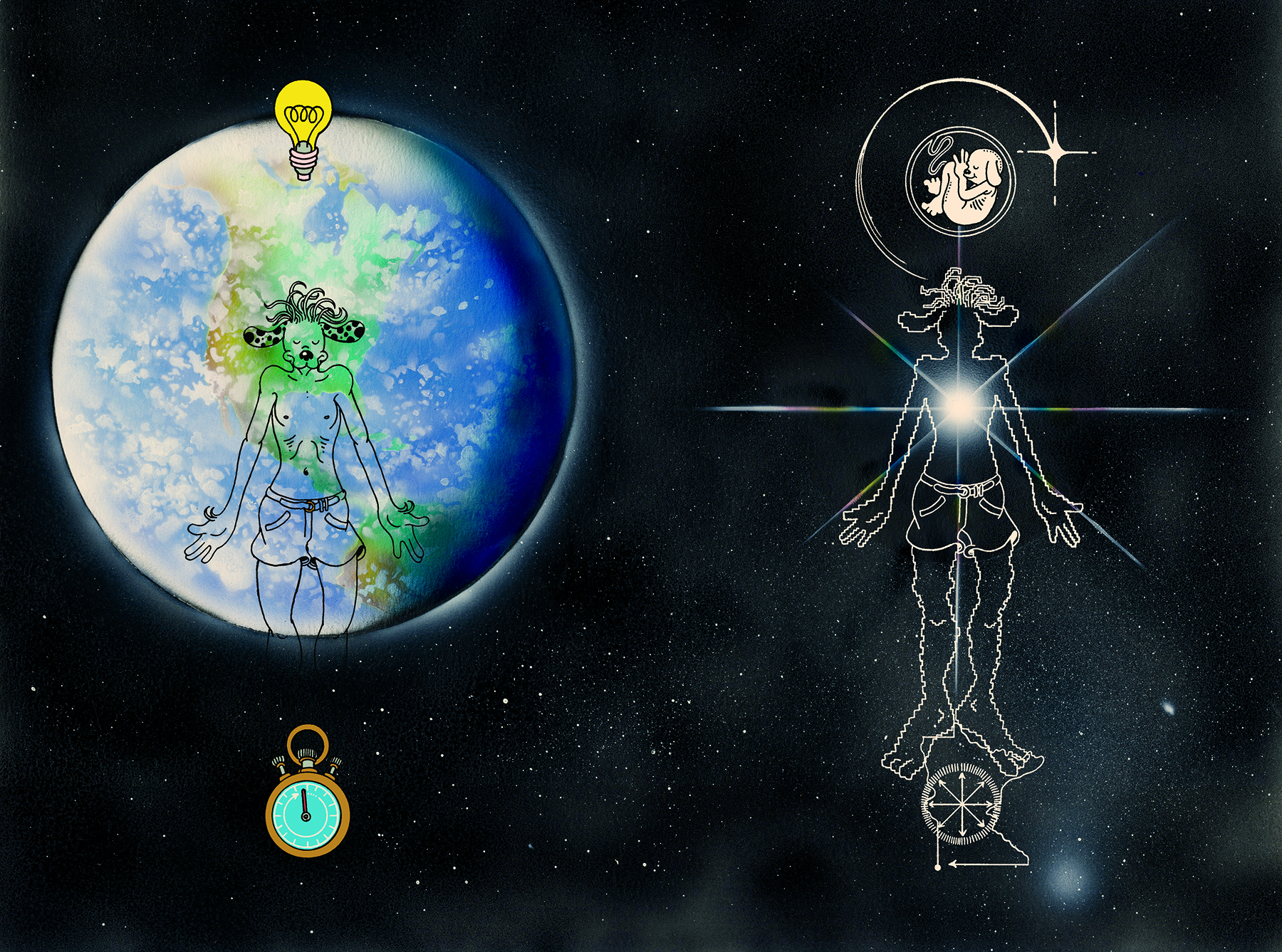
Back in Spring, The Huberty & Breyne Gallery in Paris hosted an art exhibition featuring original drawings from Mycelium Wassonii and Bicycle Day. It’s not uncommon for you to make digital revisions, as these aren’t created to be final products. What was it like showcasing that material and witnessing people appreciate, not only your work, but a rawer version of it at that stage in the process?
Well, I always feel like I’m a bit of a white-out baby and I use way too much white-out…but people seemed pretty shocked that it basically for the most part looks exactly like it does on the page. Either, that or the people at the exhibition were just being nice to me. Haha. I don’t use pencil so it really is just the inks and that’s it. I thought the show came out pretty great. I had a great time in Paris and for those interested… Huberty and Breyne still has a couple of the originals in Europe. They are a great gallery and did a great job with it.
You made the conscious decision to use neon Pantones in Bicycle Day, because they are colors that do not occur naturally and are lab-created like LSD. Along with the tribal elements, Mycelium Wassonii incorporates watercolors in reference to both the organic nature of mushrooms and the work of Roger Heim. Lilly Wave embraces the space art style of Carl Sagan collaborator, Jon Lomberg, while interspersing a distinctly retro, digital aesthetic throughout. Did you learn anything particularly interesting about Lomberg? How about regarding John C. Lilly’s theories about “Programming and metaprogramming in the Human Biocomputer?”
Well, I did read that book as part of the research…and tried to sprinkle some ideas I ripped from the People’s Computer Company Newsletter. Didn’t really learn anything about Jon Lomberg—but do love his work. And tried to reference it in my own way.
Your attention to detail extends to the book covers, which you clearly put a lot of thought into. Mycelium Wassonii has an Earthy Be Here Now aesthetic and wormy organic text, while the Lilly Wave cover is all about sonar and circuitry. Are lettering and typography things you’ve historically had an interest in or a passion for?
Of course. Love Typography. Wanted the cover to have a cybernetics feel to it because Lilly was also involved with that whole cast. And those books are really rooted in the technology available but pushing it to the limit. So magnetic tape and what-not.
Is your signature on the covers a nod to the Indian ink splashes of Ralph Steadman?
Probably? I never thought of that. I just like a loose line next to a tight one. And feel like my signature loose…next to tight Text really shows the full range of what’s possible with my line work.
There are a couple of Mad Magazine-esque “fold-ins” in the book. Did you grow up a fan of Al Jaffee‘s work? Was their inclusion a reference to folding time?
Of course I know Jaffee…and yes. Turns out those are really hard…wish I had time to dive more into fold-ins and get better at it. Main idea there…is you can turn on and off the lights in the city of Los Angeles and in the second spread…you can remove and replace Lilly’s member. Much like the Ecco aliens did.
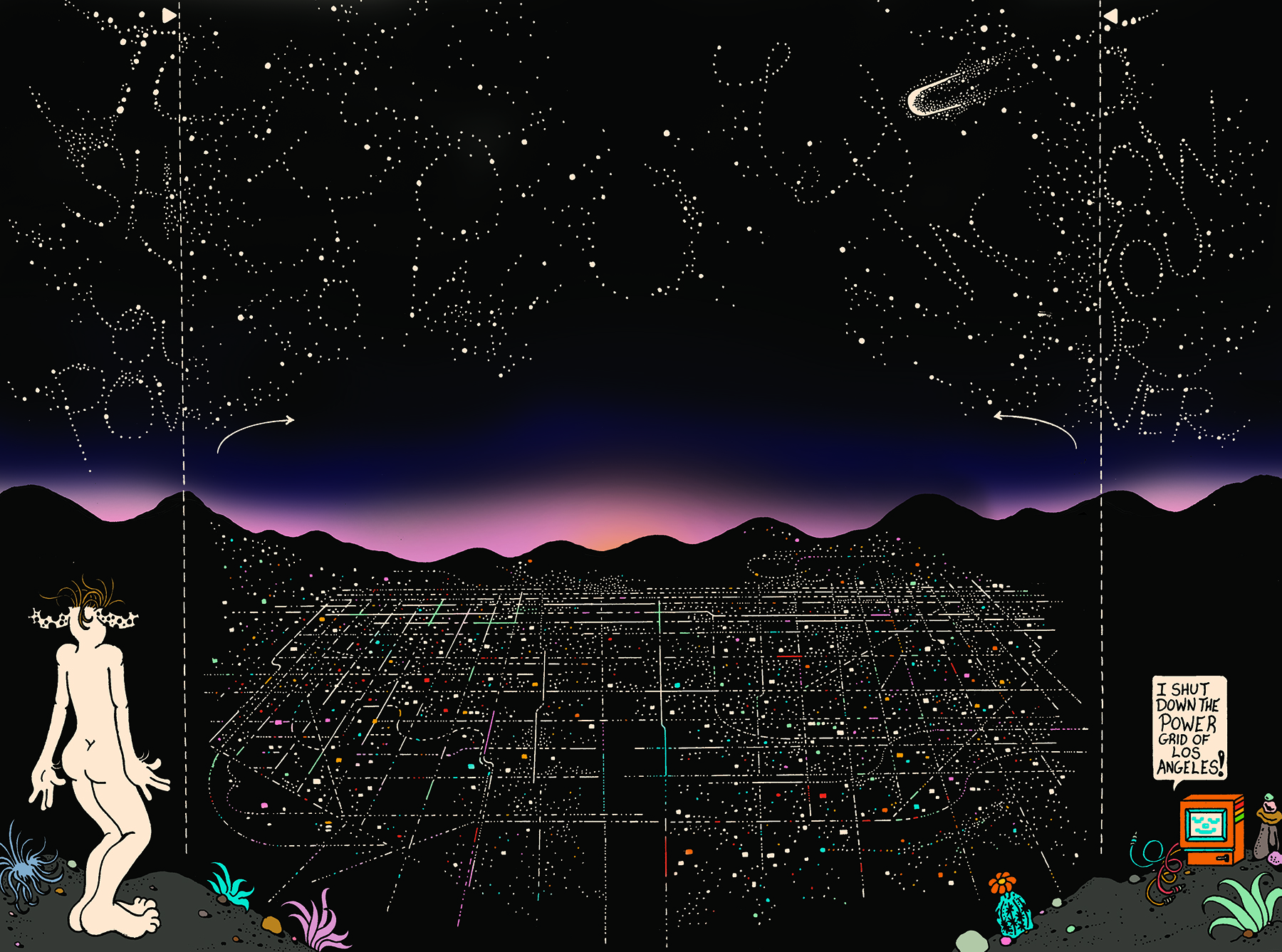
At the end of the book is a circular diagram that resembles an archery target. The center is labeled with “ob/op” (observer/operator), while the outer ring is marked as “external reality.” It reminds me of a similar diagram presented by Swiss Jungian psychologist, Marie-Louise von Franz, in her book Time: Rhythm And Repose (1978) wherein she compares time to a “spinning wheel.” In her diagram, the centermost point is designated as the “timeless center,” in which there is no motion and time ceases to exist. Working outward, the next ring is what Romanian philosopher/historian of religion, Mircea Eliade referred to as the “illud tempus.” From there is “aeonic time” and “ego time,” with each moving increasingly faster the further it extends to the edge.
When I first learned about the chart, 20 years ago, I’d been half-seriously pitching my stoned idea that the secret to time travel was the water weenie. This was based on the way that those novelty toys fold into themselves. In relation to the chart, that would be like the outermost ring of ego-time folding into the timeless center indefinitely. I remember certain people trying to tell me that my water weenie theory was essentially how a black hole operates, but I’d have to revisit the whole thing to gain any real clarity. I was really just being a goof. I can tell you that, years later, I explained it to this old wingnut I met who castrated himself and claimed to be a “time cop,” and his head nearly exploded.
I’m curious about this diagram in your book and if there is any overlap in its concept. There is mention of Lilly trying to “communicate with [a] future entity.” Did he express legitimate interest or belief in communicating or traveling through time? He seemed to treat K-holes like wormholes.
So that’s a copy of a diagram in Lilly’s book. I mean…according to them he did communicate with extraterrestrials and enter into new worlds…through both K and Isolation. There’s the Leaky Brain hypothesis that Lilly has…where all time is somewhat bent. But makes sense that time and space would be a factor in all of Lilly’s work…floating and removing—physical space/sensation—and then throwing K into the Mix.
On a less intense note, I recently hung out with Jay Howell, who I believe you’re acquainted with. Jay based an entire episode of Sanjay and Craig around his claim that he is notorious for never throwing up. Inversely, I’ve seen you reference vomiting in more than a few different videos and articles. Would you say that you puke more than the average person? Are you just more likely to discuss it?
Haha, I have acid reflux. So, I could throw up at any time any place. Haven’t thrown up in a bit…because I monitor what time my last food is…and don’t eat until a couple of hours after I wake up. However, sometimes you mess up…and then it happens.
Thanks for your time. I have one last question. Back in October, you posted a drawing you did for the New York Times and it had a human face. Before you go, could you just confirm that you remain ride or die with adult contemporary dog-face for anyone that may be concerned?
Haha, I might throw more people in the mix! Want to do something that’s more of a mix—we’ll see…don’t get too comfortable!